More Odds & Ends: Throne of Eldraine
This week I'm answering more reader questions about the design of Throne of Eldraine, so let's get right to it.
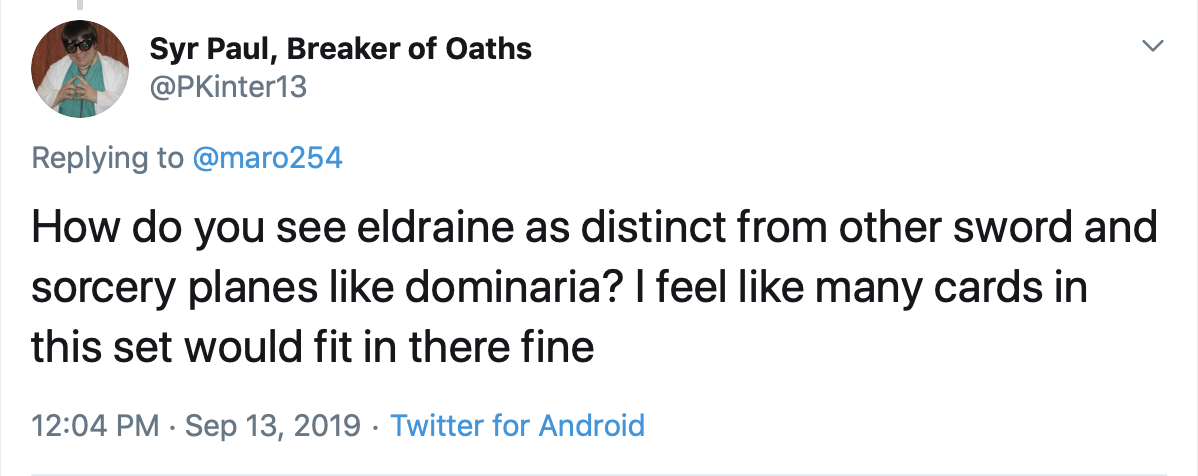
One of the big reasons I pitched adding in the fairy-tale component to Throne of Eldraine was that we have previously made worlds with a high-fantasy element that feel similar to Arthurian stories (Dominaria and the Bant shard of Alara being the major ones). Using the fairy-tale elements (what we call "the Wilds" in Throne of Eldraine) gave all the Knights a unique set of creatures to fight against and allowed us to give the world a distinctive feel.
We didn't stop there, though. Eldraine's courts take the Arthurian structure and put it through the lens of the Magic color pie. There isn't a single court, but five unique courts each with their own take on the archetype. The Knights of Dominaria and Bant are all of a similar cloth and don't have nearly as much breadth as Eldraine's Knights, both in philosophy and in the range of creatures you can see as Knights. On most other worlds, all the Knights are Human.
We also were able to play with a lot of top-down tropes specifically from Arthurian legend (Excalibur, the Holy Grail, the Lady of the Lake, Merlin, the Black Knight, the Round Table, etc.). This adds some extra flavor to Eldraine.
But all that said, you're correct in that there is some crossover. It's hard to avoid when you're playing in the heart of the source material for a lot of fantasy stories. Hopefully, we've created enough differences to give Eldraine its own identity.

Throne of Eldraine had an excellent exploratory design, and we walked into vision design with a strong feel for the overall world. I believe we spent the beginning of the first meeting walking through the five courts and talking about what element of the Arthurian part of the set we could put into each color. We also started talking about what kind of cycles we might want. The second part of the meeting was us walking through our giant list of fairy-tale tropes and exploring where we could find cool designs. It was very much a "We know what we want, so let's start digging through how to bring it to life" kind of design meeting.
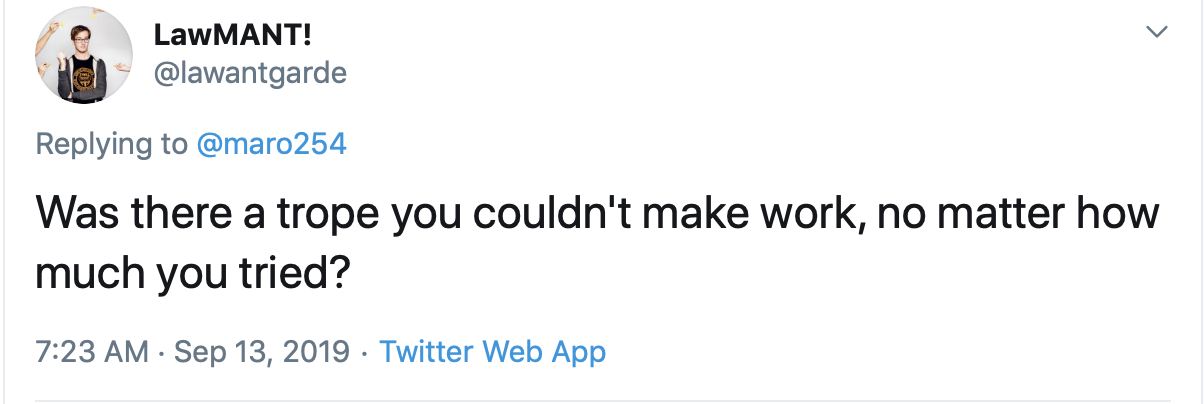
It wasn't so much there were things we couldn't make work as there were a lot of limitations we ran into:
#1 – Things Off Limits
From early in the process, we worked with the Creative team to figure out what was appropriate and inappropriate for the world. Last week, for example, I talked about how we chose not to do talking animals. Some of the designs didn't work out because they didn't fit creatively into the world.
#2 – Too Much from One Story
Also, as I explained last week, we broke down every fairy tale into the many cards we could make from it. Some of the times we killed cards not because we didn't like the design, but we felt we were hitting too many things from the same story.
#3 – Not Enough People Got It
This is the category probably closest to your question. Some tropes didn't work out not because we couldn't make designs for them, but not enough people seemed to know the fairy tale they were referencing. Normally, in top-down design, we'll do more obscure references (things like Hundred-Handed One in Theros) at higher rarities, but fairy tales are such a deep well, we didn't really need to. Also, the core of the fairy-tale design was a system where players got to mix and match different open-ended fairy-tale components, so their game created its own fairy-tale story, and to accomplish this, we needed to focus on the better-known tropes.
#4 – There Were Better Designs
The one other thing that stopped some tropes from getting cards was that there were so many cool designs, we had to pick and choose the best ones. There was only so much room in the set.
All in all, to answer your question, no, fairy-tale tropes tended to translate very well into Magic cards.
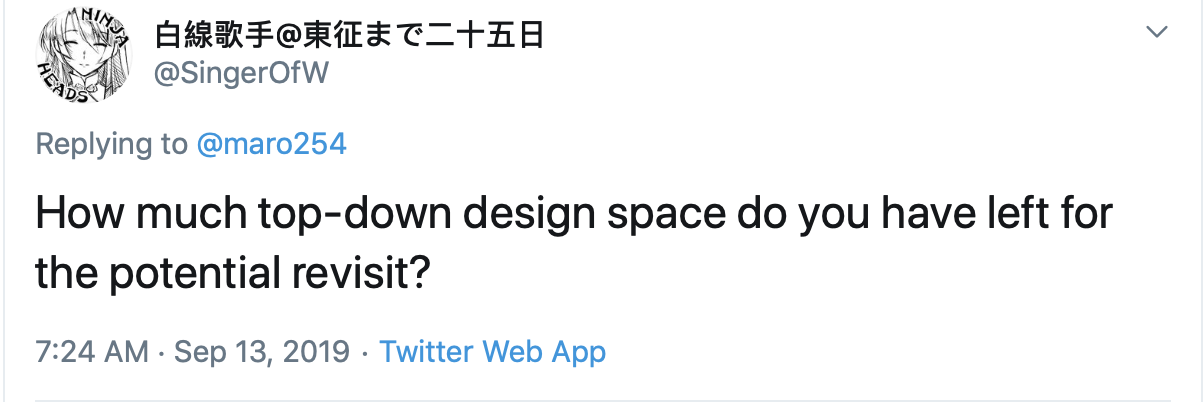
So much! Like I said last week, the list of tropes was hundreds long. Throne of Eldraine has somewhere between 75 and 100 top-down cards depending on how you want to count them. (And I'm talking about card designs directly referencing specific elements, not just general archetypes like "loyal knight"—there are a lot of those as well.) For example, think of any fairy tale. If it's famous enough, odds are we referenced it at least once. That same fairy tale has other components we didn't do. We had Goldilocks, but no broken chair or bowl of porridge. We had Jack and the Beanstalk, but no beanstalk or self-playing harp. We had Beauty and the Beast, but no transformation into a prince or a rose. We didn't even have a Little Red Riding Hood (although, in Throne of Eldraine, Rowan sort of stood in for her). While we did a lot, there's plenty of meat left on the bones for a return trip. We did pick clean most of the Arthurian references though, at least the better-known ones. A return might have us digging into a little more obscure stuff on that side.
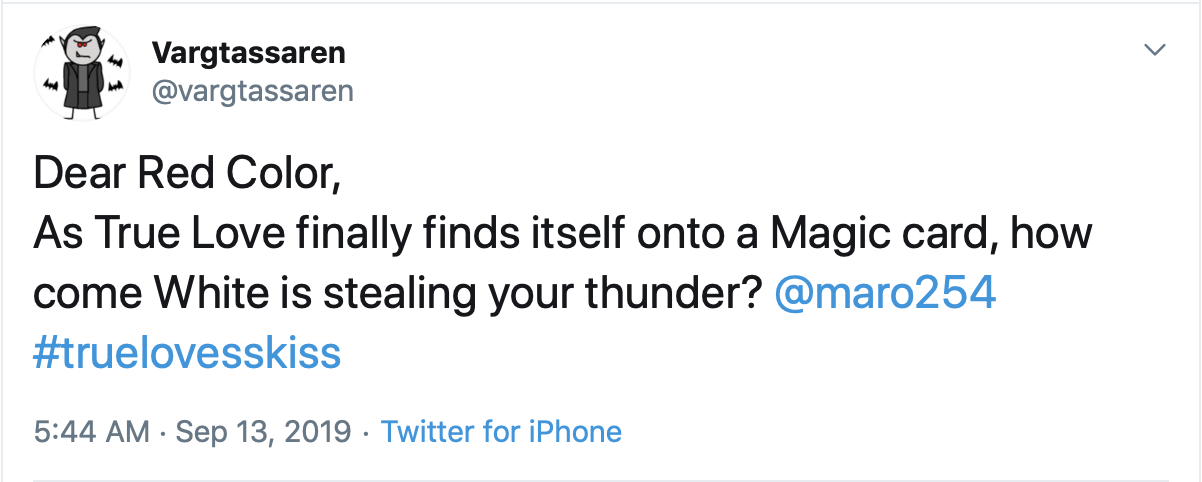
I talk a lot about how it's hard to show the non-angry, emotional side of red in a game about combat. We finally made a card that plays into the passion of love, and red didn't get it—what's going on? Well, gameplay is to blame. A big part of the design of the top-down fairy-tale cards was creating open-ended designs that clicked into one another. This would allow endearing moments of gameplay where you got to recreate a fairy-tale moment while playing a game of Magic. What's the purpose of True Love's Kiss? Well, to wake up creatures that have been put to sleep by a magic spell. How exactly were we going to represent the magical sleeping spell? Claustrophobia seemed like a great answer. It locks down a creature until the spell is removed. That's pretty flavorful. So we kept the rules text and changed the name.
This meant that True Love's Kiss had to be an answer to Charmed Sleep. Red doesn't have an answer to enchantments. This meant it had to be white or green, and white just felt more appropriate. Once we designed Glass Casket, we allowed True Love's Kiss to also destroy artifacts so it could wake the creature trapped inside the casket (as after Sleeping Beauty, Snow White is the other big fairy tale with this trope).
For fans of red, I feel your pain, but as I often say, in Magic design, gameplay will most often trump flavor when the two come into conflict.

To the best of my knowledge, that was the nugget that the characters were built around. We've been playing around a bit more recently with giving Planeswalkers unique ways to work as a Planeswalker (Yanggu travels with his dog, Wrenn bonds with a treefolk that travels with her, The Wanderer is forced to keep planeswalking, etc.) We put them on one card because the players have been asking for us to make a planeswalker card with two Planeswalker characters on it for years, and this seemed like the slam-dunk execution.
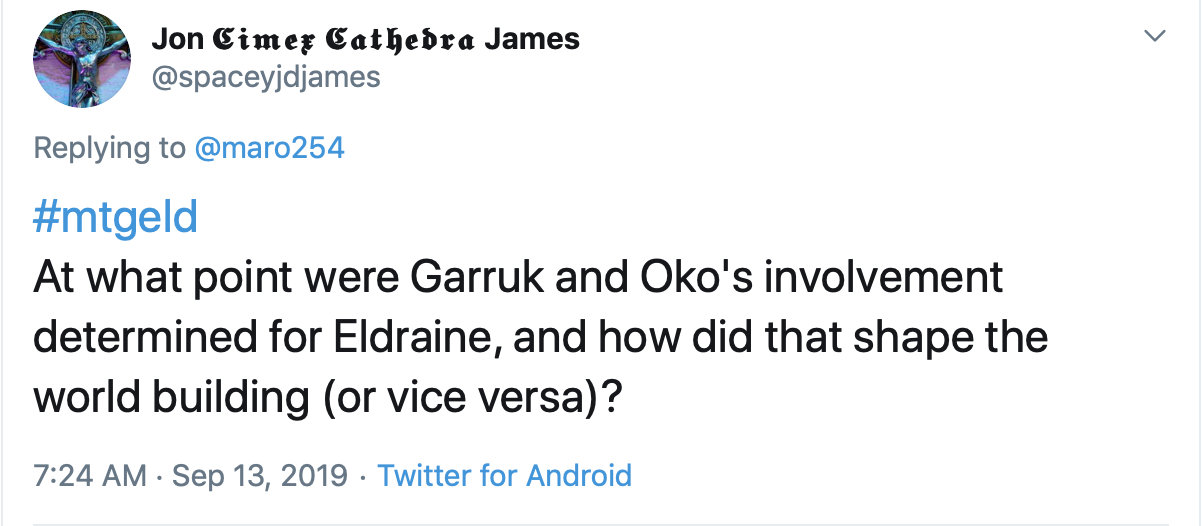
Garruk was part of the set from the moment we said "fairy tale." He was a slam-dunk Huntsman, and we'd been eager to get back to him story-wise. (He was involved in the Dominaria story in the early drafts, but there wasn't enough room, and, as he was a side story, he got removed.) I believe Oko was created as they were mapping out the basic outline for the Throne of Eldraine story, but that happened much later than Garruk's addition.

After the impact of Kaladesh on various environments, R&D had a meeting to discuss the future of artifacts in the game. We came to the conclusion that we had two basic paths. We could stop pushing artifacts (save very narrow ones) and avoid doing artifact-focused sets, or we could tap into the color pie and start making more colored artifacts. (We'd been doing them for over ten years.) The latter path seemed preferable, so we made the choice to start upping the number of colored artifacts in our sets. Both War of the Spark and Core Set 2020 added colored artifacts, but neither set had much of an artifact theme, so there wasn't a lot of focus on it.
Throne of Eldraine, in contrast, was doing top-down fairy tales and Arthurian legends, and those had a lot of objects in them (Excalibur, the Holy Grail, the Round Table, the glass slipper, the pumpkin carriage, the glass casket, Pinocchio, the Gingerbread Man, the Magic Mirror, etc.), so we knew we needed to have a larger volume of artifacts. This seemed like the perfect chance to embrace our new philosophy and play into the monocolor theme of the set.
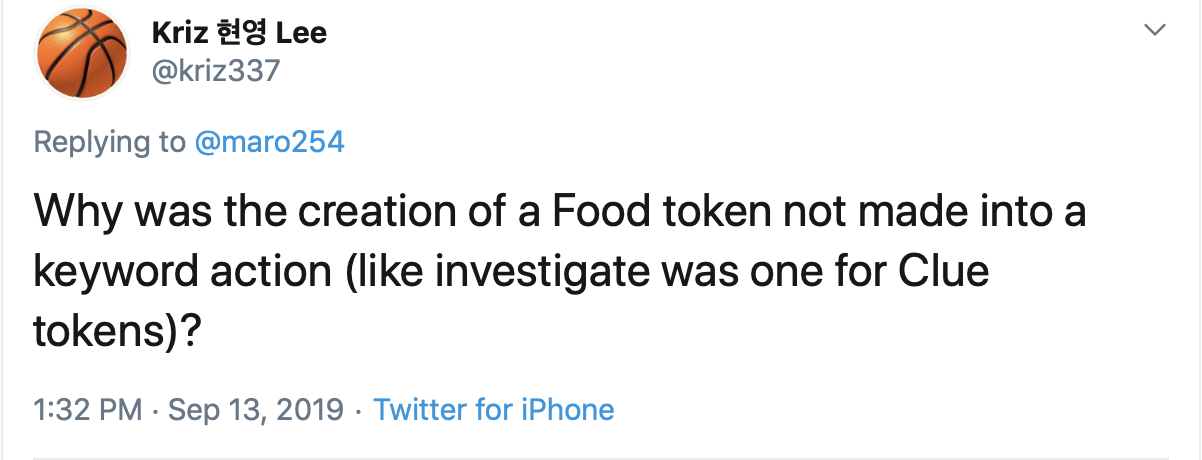
Two reasons. First, because Food tokens didn't flavorfully need the support of a keyword action. If we told you that you got a Food token, it was pretty clear what the flavor of that action was. In contrast, if we tell you that you get a Clue token, it's not as obvious. In that case, having investigate as a keyword action drives home what the flavor is. You're in the middle of investigating, and you find a clue. Second, Food was being used flavorfully in more contexts than Clues, making it harder to pick a single word. For example, you could "prepare" the Food, but then you're cutting down the different card concepts we could use.
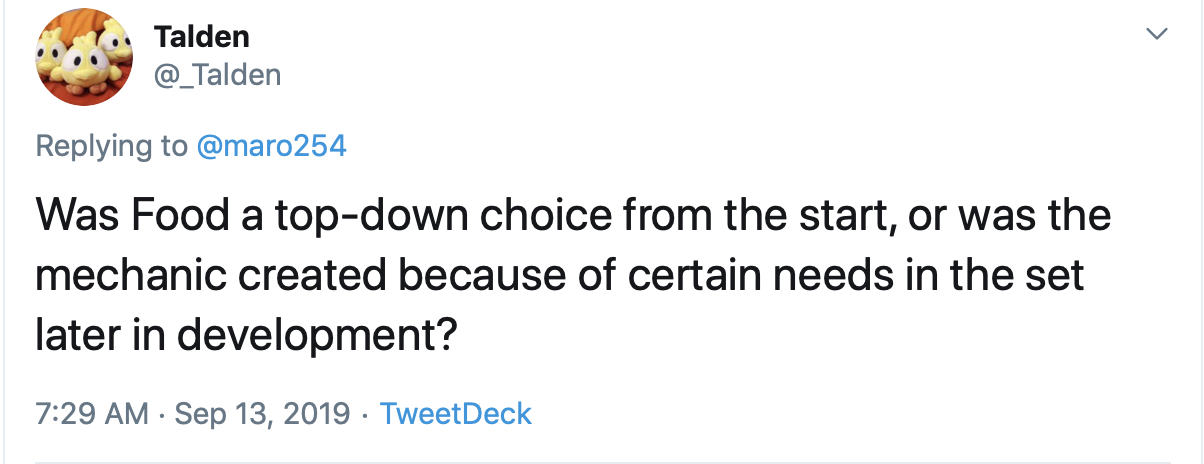
Interestingly, the token we used in vision design was Gold tokens, because there were a number of fairy-tale tropes involving gold. Both Gilded Goose and Spinning Wheel originally created Gold tokens. In set design, they realized how many food tropes there were and decided to trade in the Gold tokens for Food tokens. I think the inspiration came from a card Vision Design had made called Bake into a Pie, which at the time was a white Arrest variant that allowed the controller of the creature to "eat" it by paying mana and sacrificing it for life.

Just the fairy-tale aspect of it. As I've talked about numerous times during the previews, I'd been trying to make a fairy-tale set for almost a decade. When you work so hard over so many years to make something happen and it finally does, there's naturally a lot of desire to start talking about it. But I've been doing this a long time, so I just focused on my projects at hand knowing that it would eventually come out. (Normally, there's a two-year gap between me turning over a vision design and it seeing print.) I was very excited when I was informed that I was going to be the person premiering the set during my panel at San Diego Comic-Con.
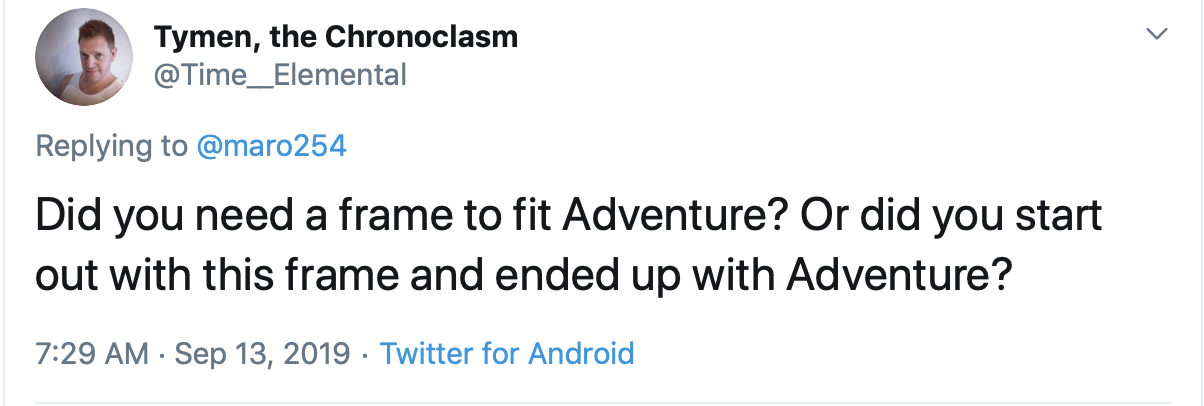
Most of the time, we start with the mechanic and build a frame to match it. The reason for this is that we don't want to waste frame-building resources until we're confident the mechanic is going to be in the set. But, as we're more willing to experiment with frame designs, we're getting more designs that start with the premise that they'll have a special frame. For example, when I first came up with host and augment for Unstable, I'd pictured it working visually close to how it ended up. Adventure frames came later in the process because there was a lot of exploration about how to make Adventures work. You can read Mark Gottlieb's article all about the design of the Adventure mechanic here.

We do make new creature types from time to time. Throne of Eldraine just has a few more new ones than usual as the world kind of allowed us to justify making a bunch of creature types we've meant to make for a while. Let's walk through them.
Warlock – For a long time, we've had four spellcasting creature types (Wizard, Shaman, Cleric, and Druid), and Magic is a game that loves the number five. We've been talking about adding a black-centric spellcasting type for years, but never got around to it. Throne of Eldraine just felt like the perfect place to make this happen as there were so many tropes in this space. There was a bunch of discussion around whether it was supposed to be Warlock or Witch, but we ended up going with Warlock for various reasons (the biggest ones being the popularity of warlock in video games and the fact that there are real-world religions that refer to their members as witches).
Peasant – Many years ago, we had a Townsfolk creature type. It went away in the Grand Creature Type Update. The problem is that we often make creatures without any defined role other than living on a particular Plane, and we realized that maybe getting rid of Townsfolk was a mistake. Throne of Eldraine was also a good place to make a new creature type for this. We considered Townsfolk but decided that Peasant was more universal as not every world was full of towns.
Noble – This is another creature type we've talked about adding forever. The game just has a lot of people whose job it is to rule over others, and it felt weird not to have a class that covered that. Throne of Eldraine was full of kings and queens, princes and princesses, so it seemed like the right time to finally add Noble.
Mouse – This creature type exists only because the Enchanted Carriage needed white Mice for flavor. We talked about the card making Rat tokens as that's the rodent we'd make in a vacuum, but the flavor just felt so off. I even suggested Squirrels, but no one else seemed to go for it. Now that we've made Mouse, maybe its existence will encourage us to make more Mice, but I don't expect a lot of Mice in Magic's future.
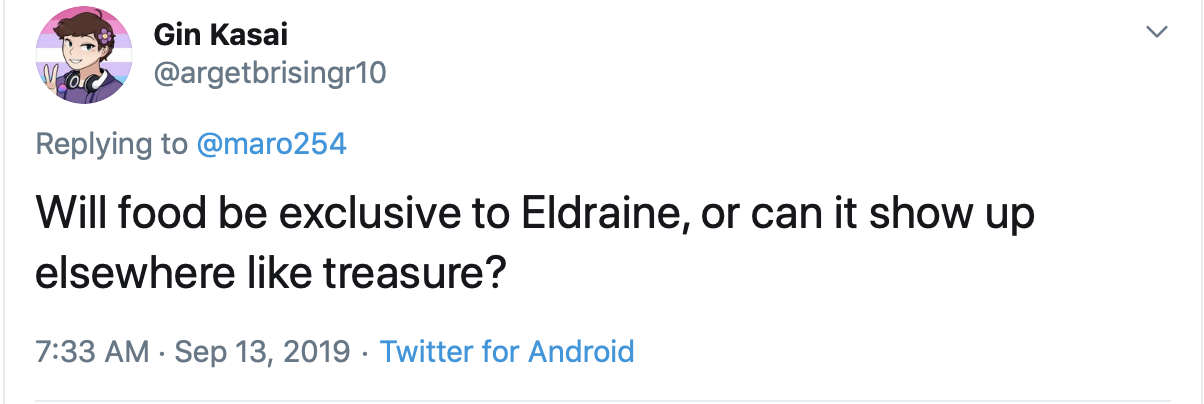
Unlike Mouse, I have high confidence we'll see more Food tokens in the future. It's flavorful and pretty simple.

"Miss Ginger" is what many are calling the gingerbread woman from the Throne of Eldraine trailer. The reason she doesn't have a card is that she didn't exist until we made the trailer, which happened long after the card set was finalized. Whenever this happens—a character gets created by some element downstream from the card set (the flavor text, the story, the trailer, etc.)—we add it to a list of cards the audience is interested in having and find a home for it later on, either in a return set or a supplemental set not centered on a single Plane.
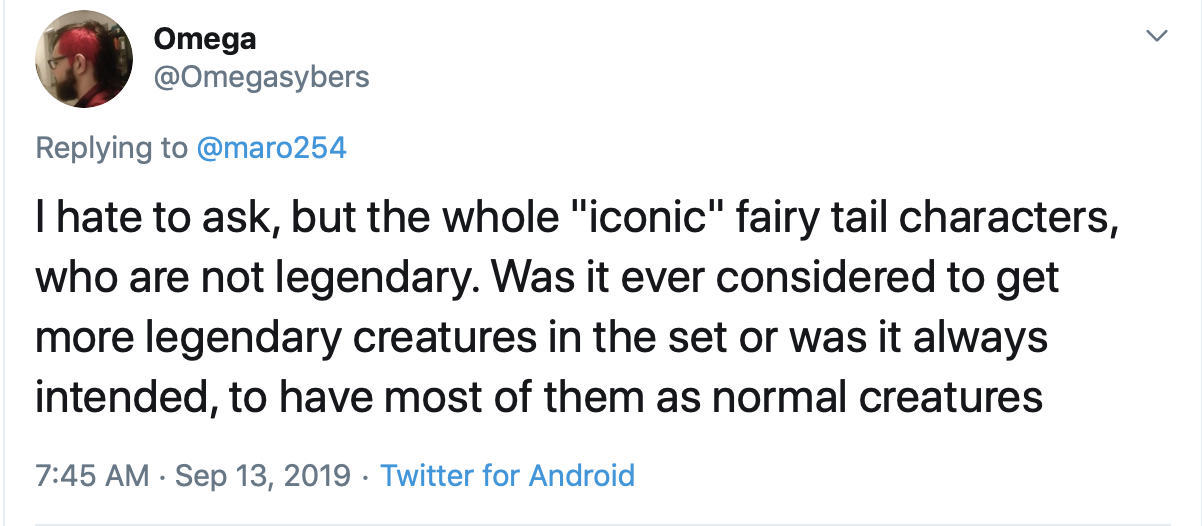
There are a number of reasons that there aren't a lot of legendary fairy-tale characters. Let me walk through them.
#1 – Top-down designs are focused on capturing the essence of the flavor through mechanical execution. In general, that doesn't lead to cards that inspire decks. Take Gingerbrute as an example. I love how it captures the "you can't catch me" flavor of the Gingerbread Man, but that card would be miserable as a commander. It's flavorful, but there isn't much to build around. If we stumbled upon a design that could do both, we were willing to make them legendary, but we didn't want additional asks that kept our top-down designs from being as awesome as they could be.
#2 – Not every world gets to have a major legendary theme. There's a lot of support required to make a set like Dominaria. That said, Throne of Eldraine is above average for legendary creatures. Being that there's a limit of how many legendary creatures we could make, we leaned into where the world wanted them. That led to our cycle of court leaders and cycle of famous Knights. Unlike the fairy-tale side, the Arthurian side of the set had a lot of desire for legendary creatures, but not ones that were prescriptive in needing to match specific characters. A leader or a Knight gave us a lot of room to design cards that could inspire decks.
#3 – We also have to prioritize leaving legendary creature slots for characters in the story, and we leaned a lot more on the Arthurian side of the set for those. Goldilocks works much better as a card than a character in the story.
No More Questions
That's all the time I have for today. I want to thank everyone who sent in a question. I apologize if I wasn't able to get to yours. As always, I'm eager to hear your thoughts on my answers or Throne of Eldraine in general. You can email me or contact me through any of my social media accounts (Twitter, Tumblr, and Instagram).
Join me next week when I tell the story behind the making of the Bolas Arc.
Until then, may you make unique fairy tales all your own.
#681: Math in Magic
#681: Math in Magic
36:14
In this podcast, I talk about how Magic design involves a lot of math.
#682: Connecting Set & Story
#682: Connecting Set & Story
In this podcast, I talk about what we have to do in design to make sure that the set and story align.
- Episode 680 Diversity in Game Design
- Episode 679 Changing the Color Pie
- Episode 678 Small Talk with Sarah

